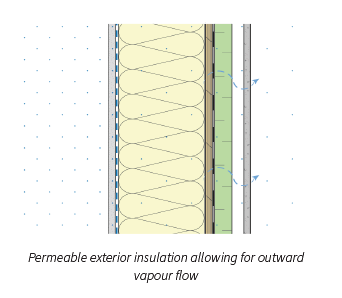Vapour Flow & Vapour Permeability of Building Materials
While water penetration is an important consideration, condensation moisture due to vapour diffusion (i.e., vapour flow) can also lead to damage if not effectively controlled. Condensation occurs on surfaces that are colder than the dew point temperature of the air they are exposed to. The variables that impact the potential for condensation include the temperature of surfaces, the air temperature, and the amount of vapour in the air (i.e., the dew point temperature; higher RH means higher dew point).
Controlling condensation can be achieved by:
- Minimizing vapour flow into/through assemblies by installing a vapour control layer such as a vapour retarder.
- Reducing the amount of moisture in the indoor air.
- Keeping surfaces warm, both interior surfaces and surfaces within building assemblies.
- Controlling air movement into/through assemblies.
The predominant vapour flow through an insulated wood-frame assemblies in cool climates occurs outwards and should be controlled. There is increased flow in homes with high RH and colder exterior temperatures. Exterior insulation, sheathing, and the WRB can slow/stop the continued outward flow (diffusion) of vapour. Exterior walls should be designed to allow for the flow of vapour (for drying) in at least one direction from the plane of the moisture sensitive sheathing and stud cavity.
For this reason using permeable exterior insulation is beneficial because it allows vapour to flow through to the exterior.
